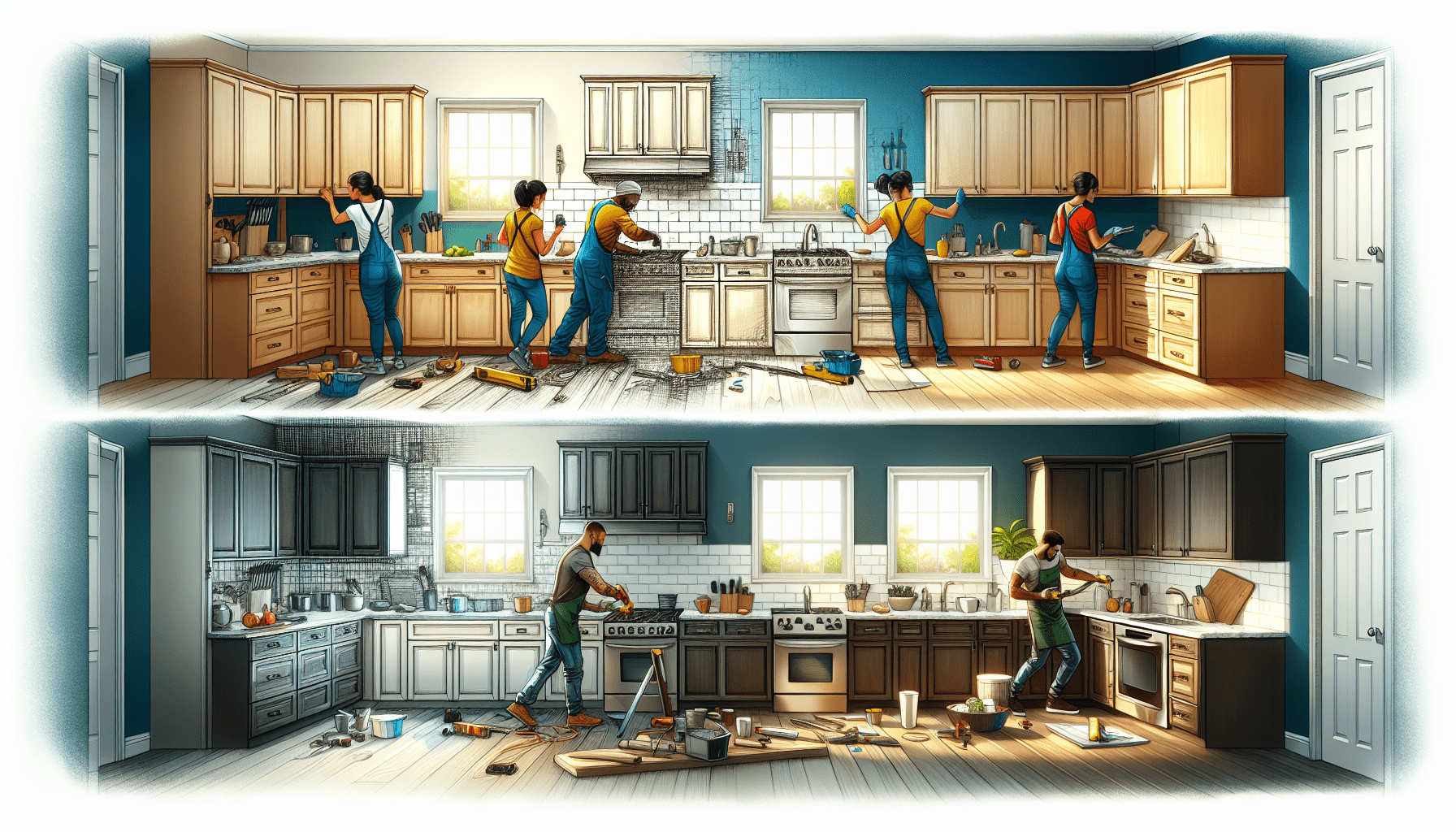What Order Should I Renovate My Kitchen?
So, you’ve decided to take on the exciting adventure of renovating your kitchen. But where do you start? With so many aspects to consider, it can be overwhelming to determine the best order in which to tackle your kitchen renovations. From cabinets to countertops, flooring to lighting, each element plays a crucial role in creating your dream kitchen. In this article, we will guide you through the process, providing valuable insights and tips to help you plan and prioritize your kitchen renovations. So grab a cup of coffee, put your feet up, and let’s dive into the world of kitchen renovation order!

Assessing your needs
Evaluate your current kitchen
Before diving into a kitchen renovation, it is important to evaluate your current kitchen and identify its strengths and weaknesses. Take a good look at the layout, functionality, and overall design of your existing kitchen. Are you happy with the flow of the space? Are there any storage problems? Is the overall aesthetic outdated? Understanding the current state of your kitchen will help you determine what changes need to be made during the renovation process.
Identify your renovation goals
Once you have assessed your current kitchen, it’s time to identify your renovation goals. What do you want to achieve with this renovation? Are you looking to create more counter space? Do you want to update the style of your kitchen? Are you in need of more storage? By clearly defining your renovation goals, you will have a clear vision of what you want to accomplish, making the planning process much smoother.
Consider your budget
Before getting too carried away with your renovation plans, it is essential to consider your budget. Renovating a kitchen can be a significant investment, so it’s crucial to determine how much you are willing to spend. Be realistic about your budget and prioritize what aspects of the renovation are most important to you. This will help you make informed decisions throughout the process and avoid any financial stress down the line.
Planning the layout
Consult with a professional architect or kitchen designer
When it comes to planning the layout of your new kitchen, it is highly recommended to consult with a professional architect or kitchen designer. They have the expertise to create a functional and aesthetically pleasing design that maximizes the space available. A professional can also ensure that the layout meets building codes and regulations, as well as make recommendations based on your needs and preferences.
Consider the work triangle
The work triangle is an important concept in kitchen design and refers to the positioning of the three main work areas: the refrigerator, the sink, and the cooking surface. The goal is to create an efficient workflow between these areas, making meal prep and cooking easier and more enjoyable. When planning your kitchen layout, consider the distance and accessibility between these key elements to optimize functionality.
Determine the placement of appliances and fixtures
Once you have established the overall layout and work triangle of your kitchen, it’s time to determine the specific placement of appliances and fixtures. Consider the size and dimensions of each item, as well as any necessary clearances or ventilation requirements. Pay attention to the proximity of electrical and plumbing connections to ensure a smooth installation process. Thinking through these details in advance will save you time and potential headaches during the renovation.
Structural changes
Demolition and removal of existing features
One of the first steps in any kitchen renovation is demolishing and removing existing features that are no longer necessary or desired. This could include old cabinets, countertops, flooring, and even walls or partitions. It is important to approach this phase with caution and safety in mind. If you are unsure or uncomfortable with DIY demolition, it is recommended to hire professionals who can efficiently and safely remove these features.
Modifying walls or partitions
If you are looking to create a more open concept kitchen, you may need to modify or remove walls or partitions. This can dramatically change the layout and flow of the space, allowing for better sightlines and increased functionality. However, it is crucial to consult with a professional before making any structural changes to ensure that they can be safely implemented and that any necessary permits are obtained.
Electrical and plumbing work
Depending on the extent of your kitchen renovation, you may need to update or modify your electrical and plumbing systems. This could involve rewiring for new lighting fixtures or outlets, relocating plumbing lines for sinks or appliances, or installing additional electrical circuits for larger appliances. Due to the complexity and potential safety risks involved, it is highly recommended to hire licensed professionals for these tasks.
Flooring
Remove old flooring
Once the necessary demolition work has been completed, it’s time to address the flooring in your kitchen. Start by removing the old flooring material, whether it’s outdated linoleum, worn-out tiles, or worn carpet. This is an opportunity to start fresh and create a clean slate for your new kitchen design.
Repair or replace subfloor if necessary
After removing the old flooring, inspect the subfloor for any damage or rot. If there are any issues, it is important to repair or replace the subfloor before proceeding with the installation of new flooring. A sturdy and even subfloor is essential for ensuring the longevity and stability of your new kitchen floor.
Install new flooring
Once the subfloor is in good condition, it’s time to install your new kitchen flooring. There are many options to choose from, including hardwood, laminate, tile, vinyl, and even concrete. Consider the style, durability, and maintenance requirements of each material to find the best fit for your lifestyle and design preferences. Whether you opt for a sleek tile or warm hardwood, make sure to follow the manufacturer’s instructions for proper installation.

Cabinetry and storage
Consider the style and material of cabinets
Cabinets play a vital role in both the functionality and aesthetics of your kitchen, so it’s important to carefully consider the style and material options available. Whether you prefer traditional, modern, or farmhouse-style cabinets, there are countless designs to choose from. Additionally, consider the durability and maintenance requirements of different materials like wood, laminate, or thermofoil to ensure your cabinets stand the test of time.
Choose the layout and configuration
Next, determine the layout and configuration of your new cabinets. This will depend on the size and shape of your kitchen, as well as the storage needs and preferences of your household. Think about the placement of drawers, shelves, and specialty storage solutions like pull-out pantry cabinets or corner lazy susans. Customizing the layout to suit your specific needs will maximize the functionality of your kitchen.
Install cabinets and shelves
Once you have selected the style, material, and layout of your cabinets, it’s time to install them. This can be a complex task, so it is recommended to hire professionals who have experience in cabinet installation. They will ensure that the cabinets are securely and accurately installed, leaving no room for errors or instability. Additionally, consider installing shelves or built-in storage solutions to further optimize the use of space in your kitchen.
Countertops and backsplash
Select the type of countertop material
Countertops are a prominent feature in any kitchen and can greatly impact its overall look and feel. There are a wide variety of countertop materials to choose from, including granite, quartz, marble, laminate, and butcher block. Each material has its own unique characteristics in terms of durability, maintenance, and aesthetic appeal. Consider your budget and lifestyle when selecting a countertop material that best suits your needs.
Measure and template for accurate installation
Before installing countertops, it is important to measure and template the area accurately. This will ensure that the countertops fit precisely and seamlessly in your kitchen. Hiring professionals to measure and template is highly recommended as they have the expertise and equipment to ensure an accurate fit. Any errors in measurement can result in costly mistakes and delays.
Install countertops and backsplash tiles
Once the measurements have been taken and the templates created, it’s time to install the countertops. A professional installation will guarantee precise cuts, secure placement, and a finished look that enhances your kitchen’s design. Additionally, consider installing a backsplash to protect the walls behind the countertops and add a decorative element. Backsplash tiles come in various materials, colors, and patterns, allowing you to personalize your kitchen’s style.
Appliances
Research and choose energy-efficient appliances
When it comes to choosing appliances for your kitchen, it is important to prioritize energy efficiency. Research different brands and models to find appliances that are not only reliable and functional but also energy-saving. Energy-efficient appliances can help reduce your utility bills in the long run and contribute to a more sustainable lifestyle.
Determine the sizes and specifications
Before making any appliance purchases, carefully measure the space available in your kitchen. Take into account the necessary clearances and consider any specific requirements for each appliance. This will ensure that the appliances you choose fit seamlessly into your kitchen design. Pay attention to important specifications like capacity, features, and finishes to meet your cooking and lifestyle needs.
Install and connect appliances
Once you have chosen your appliances, it’s time to install and connect them. Depending on the complexity of the installation, you may need to hire professionals to ensure everything is properly connected and functioning. This includes electrical and plumbing connections for items like refrigerators, dishwashers, ovens, and cooktops. Proper installation will not only ensure the longevity of your appliances but also the safety of your kitchen.
Lighting
Plan for general, task, and ambient lighting
Good lighting is essential in a kitchen to create functional and inviting spaces. When planning your kitchen lighting, consider incorporating a combination of general, task, and ambient lighting. General lighting provides overall illumination, task lighting focuses on specific work areas like countertops and stoves, and ambient lighting adds a warm and inviting atmosphere. By layering these different types of lighting, you can achieve a well-lit and visually appealing kitchen.
Consider under cabinet lighting
Under cabinet lighting is a popular choice in kitchens as it provides additional task lighting and enhances the overall aesthetic. It illuminates the countertop workspace, making food preparation and cooking easier and safer. There are various under cabinet lighting options available, including LED strips, puck lights, and tape lights. Choose a style and color temperature that complements your kitchen design and provides the desired level of illumination.
Install light fixtures and switches
Once you have planned your lighting layout, it’s time to install the light fixtures and switches. Hiring a licensed electrician is recommended to ensure all wiring is done correctly and safely. Consider the style and functionality of the light fixtures, whether you prefer recessed lights, pendant lights, or chandeliers. Additionally, strategically place light switches at convenient locations to easily control the different lighting zones in your kitchen.
Plumbing fixtures
Choose a sink and faucet style
The sink and faucet are essential components of any kitchen, so it’s important to choose a style and finish that suits your design preferences. Whether you prefer a stainless steel sink with a sleek and modern faucet or a farmhouse-style sink with a vintage-inspired faucet, there are countless options available. Consider the size, depth, and configuration of the sink to ensure it meets your washing and cooking needs.
Select a water filtration system if desired
Installing a water filtration system is a popular choice amongst homeowners looking for clean and refreshing drinking water straight from their kitchen tap. There are various types of water filtration systems available, including under-sink filters, countertop filters, and whole-house filtration systems. Research the different options and choose the one that best fits your budget, water quality needs, and maintenance requirements.
Install sink, faucet, and other plumbing fixtures
Once you have selected your sink, faucet, and any other plumbing fixtures like a garbage disposal or pot-filler faucet, it’s time to install them. Plumbing work can be complex, so it is advisable to hire a licensed professional. They will ensure that all connections are secure, free of leaks, and comply with local building codes. Proper installation is crucial for the functionality and longevity of your plumbing fixtures.
Finishing touches
Paint or wallpaper the walls
To add the final touches to your kitchen renovation, consider painting or wallpapering the walls. The color and pattern you choose can greatly impact the overall look and feel of the space. Opt for light and neutral colors to create a bright and open atmosphere or go for bold and vibrant shades to make a statement. Consider the existing design elements in your kitchen and choose a paint or wallpaper that complements the overall aesthetic.
Install window treatments
Window treatments are not only functional but also contribute to the overall design of your kitchen. Choose blinds, shades, or curtains that provide privacy, light control, and visual appeal. Consider the material, color, and style of the window treatments to match your kitchen’s theme and personal style. Install them securely and ensure they are easy to clean and maintain.
Add decorative accents and accessories
To truly personalize your renovated kitchen, add decorative accents and accessories that reflect your style and personality. This could include artwork, plants, decorative bowls or trays, and even kitchen gadgets or small appliances. Be mindful not to clutter the space and choose items that enhance the overall design while maintaining functionality. These finishing touches will bring your new kitchen to life and create a warm and inviting atmosphere.
In conclusion, renovating a kitchen requires careful planning and consideration of various factors. Assessing your needs, planning the layout, making structural changes, and choosing materials and fixtures are all key steps in ensuring a successful kitchen renovation. By following a comprehensive approach and seeking professional guidance where necessary, you can create a kitchen that not only meets your functional needs but also reflects your personal style and enhances the overall value of your home. So roll up your sleeves, grab your tape measure, and get ready to transform your kitchen into the heart of your home!




